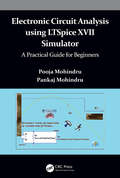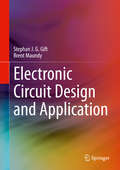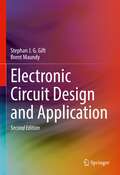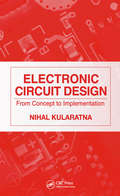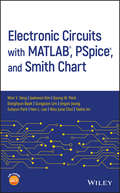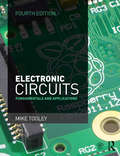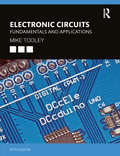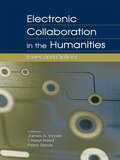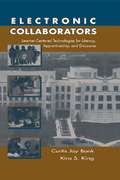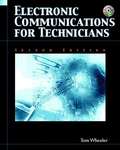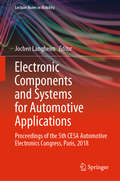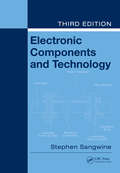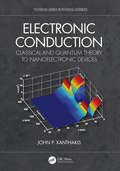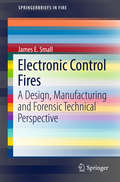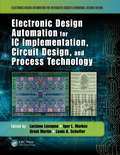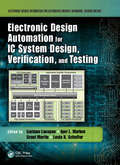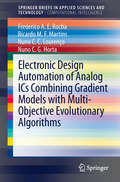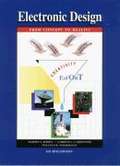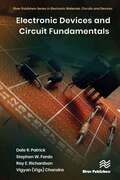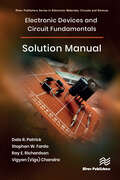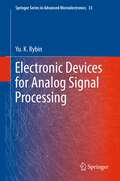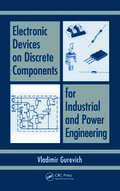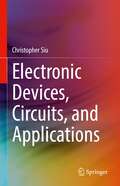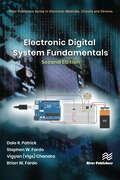- Table View
- List View
Electronic Circuit Analysis using LTSpice XVII Simulator: A Practical Guide for Beginners
by Pooja Mohindru Pankaj MohindruThis text discusses simulation process for circuits including clamper, voltage and current divider, transformer modeling, transistor as an amplifier, transistor as a switch, MOSFET modeling, RC and LC filters, step and impulse response to RL and RC circuits, amplitude modulator in a step-by-step manner for more clarity and understanding to the readers. It covers electronic circuits like rectifiers, RC filters, transistor as an amplifier, operational amplifiers, pulse response to a series RC circuit, time domain simulation with a triangular input signal, and modulation in detail. The text presents issues that occur in practical implementation of various electronic circuits and assist the readers in finding solutions to those issues using the software. Aimed at undergraduate, graduate students, and academic researchers in the areas including electrical and electronics and communications engineering, this book: Discusses simulation of analog circuits and their behavior for different parameters. Covers AC/DC circuit modeling using regular and parametric sweep methods. The theory will be augmented with practical electrical circuit examples that will help readers to better understand the topic. Discusses circuits like rectifiers, RC filters, transistor as an amplifier, and operational amplifiers in detail.
Electronic Circuit Design and Application
by Stephan J. Gift Brent MaundyThis textbook for core courses in Electronic Circuit Design teaches students the design and application of a broad range of analog electronic circuits in a comprehensive and clear manner. Readers will be enabled to design complete, functional circuits or systems. The authors first provide a foundation in the theory and operation of basic electronic devices, including the diode, bipolar junction transistor, field effect transistor, operational amplifier and current feedback amplifier. They then present comprehensive instruction on the design of working, realistic electronic circuits of varying levels of complexity, including power amplifiers, regulated power supplies, filters, oscillators and waveform generators. Many examples help the reader quickly become familiar with key design parameters and design methodology for each class of circuits. Each chapter starts from fundamental circuits and develops them step-by-step into a broad range of applications of real circuits and systems.Written to be accessible to students of varying backgrounds, this textbook presents the design of realistic, working analog electronic circuits for key systems;Includes worked examples of functioning circuits, throughout every chapter, with an emphasis on real applications;Includes numerous exercises at the end of each chapter;Uses simulations to demonstrate the functionality of the designed circuits;Enables readers to design important electronic circuits including amplifiers, power supplies and oscillators.
Electronic Circuit Design and Application
by Stephan J. Gift Brent MaundyThis textbook for core courses in Electronic Circuit Design teaches students the design and application of a broad range of analog electronic circuits in a comprehensive and clear manner. Readers will be enabled to design complete, functional circuits or systems. The authors first provide a foundation in the theory and operation of basic electronic devices, including the diode, bipolar junction transistor, field effect transistor, operational amplifier and current feedback amplifier. They then present comprehensive instruction on the design of working, realistic electronic circuits of varying levels of complexity, including power amplifiers, regulated power supplies, filters, oscillators and waveform generators. Many examples help the reader quickly become familiar with key design parameters and design methodology for each class of circuits. Each chapter starts from fundamental circuits and develops them step-by-step into a broad range of applications of real circuits and systems.Written to be accessible to students of varying backgrounds, this textbook presents the design of realistic, working analog electronic circuits for key systems;Includes worked examples of functioning circuits, throughout every chapter, with an emphasis on real applications;Includes numerous exercises at the end of each chapter;Uses simulations to demonstrate the functionality of the designed circuits;Enables readers to design important electronic circuits including amplifiers, power supplies and oscillators.
Electronic Circuit Design: From Concept to Implementation
by Nihal KularatnaWith growing consumer demand for portability and miniaturization in electronics, design engineers must concentrate on many additional aspects in their core design. The plethora of components that must be considered requires that engineers have a concise understanding of each aspect of the design process in order to prevent bug-laden prototypes. Electronic Circuit Design allows engineers to understand the total design process and develop prototypes which require little to no debugging before release. It providesstep-by-step instruction featuring modern components, such as analog and mixed signal blocks, in each chapter. The book details every aspect of the design process from conceptualization and specification to final implementation and release. The text also demonstrates how to utilize device data sheet information and associated application notes to design an electronic system. The hybrid nature of electronic system design poses a great challenge to engineers. This book equips electronics designers with the practical knowledge and tools needed to develop problem free prototypes that are ready for release.
Electronic Circuits with MATLAB, PSpice, and Smith Chart
by Kyung W. Park Won Y. Yang Jaekwon Kim Taeho Im Donghyun Baek Sungjoon Lim Jingon Joung Suhyun Park Han L. Lee Woo June ChoiProvides practical examples of circuit design and analysis using PSpice, MATLAB, and the Smith Chart This book presents the three technologies used to deal with electronic circuits: MATLAB, PSpice, and Smith chart. It gives students, researchers, and practicing engineers the necessary design and modelling tools for validating electronic design concepts involving bipolar junction transistors (BJTs), field-effect transistors (FET), OP Amp circuits, and analog filters. Electronic Circuits with MATLAB®, PSpice®, and Smith Chart presents analytical solutions with the results of MATLAB analysis and PSpice simulation. This gives the reader information about the state of the art and confidence in the legitimacy of the solution, as long as the solutions obtained by using the two software tools agree with each other. For representative examples of impedance matching and filter design, the solution using MATLAB and Smith chart (Smith V4.1) are presented for comparison and crosscheck. This approach is expected to give the reader confidence in, and a deeper understanding of, the solution. In addition, this text: Increases the reader's understanding of the underlying processes and related equations for the design and analysis of circuits Provides a stepping stone to RF (radio frequency) circuit design by demonstrating how MATLAB can be used for the design and implementation of microstrip filters Features two chapters dedicated to the application of Smith charts and two-port network theory Electronic Circuits with MATLAB®, PSpice®, and Smith Chart will be of great benefit to practicing engineers and graduate students interested in circuit theory and RF circuits.
Electronic Circuits, 4th ed: Fundamentals & Applications
by Mike TooleyElectronics explained in one volume, using both theoretical and practical applications. New chapter on Raspberry Pi Companion website contains free electronic tools to aid learning for students and a question bank for lecturers Practical investigations and questions within each chapter help reinforce learning Mike Tooley provides all the information required to get to grips with the fundamentals of electronics, detailing the underpinning knowledge necessary to appreciate the operation of a wide range of electronic circuits, including amplifiers, logic circuits, power supplies and oscillators. The fourth edition now offers an even more extensive range of topics, with extended coverage of practical areas such as Raspberry Pi. The book's content is matched to the latest pre-degree level courses (from Level 2 up to, and including, Foundation Degree and HND), making this an invaluable reference text for all study levels, and its broad coverage is combined with practical case studies based in real-world engineering contexts. In addition, each chapter includes a practical investigation designed to reinforce learning and provide a basis for further practical work. A new companion website at www.key2electronics.com offers the reader a set of spreadsheet design tools that can be used to simplify circuit calculations, as well as circuit models and templates that will enable virtual simulation of circuits in the book. These are accompanied by online self-test multiple choice questions for each chapter with automatic marking, to enable students to continually monitor their own progress and understanding. A bank of online questions for lecturers to set as assignments is also available.
Electronic Circuits: Fundamentals and Applications
by Mike TooleyElectronics explained in one volume, using both theoretical and practical applications. Mike Tooley provides all the information required to get to grips with the fundamentals of electronics, detailing the underpinning knowledge necessary to appreciate the operation of a wide range of electronic circuits, including amplifiers, logic circuits, power supplies and oscillators. The 5th edition includes an additional chapter showing how a wide range of useful electronic applications can be developed in conjunction with the increasingly popular Arduino microcontroller, as well as a new section on batteries for use in electronic equipment and some additional/updated student assignments. The book's content is matched to the latest pre-degree level courses (from Level 2 up to, and including, Foundation Degree and HND), making this an invaluable reference text for all study levels, and its broad coverage is combined with practical case studies based in real-world engineering contexts. In addition, each chapter includes a practical investigation designed to reinforce learning and provide a basis for further practical work. A companion website at http://www.key2electronics.com offers the reader a set of spreadsheet design tools that can be used to simplify circuit calculations, as well as circuit models and templates that will enable virtual simulation of circuits in the book. These are accompanied by online self-test multiple choice questions for each chapter with automatic marking, to enable students to continually monitor their own progress and understanding. A bank of online questions for lecturers to set as assignments is also available.
Electronic Collaboration in the Humanities: Issues and Options
by James A. Inman Cheryl Reed Peter SandsThis volume provides an informed view of how information technology is shaping the contemporary humanities. It specifically reflects five ideals:*humanities scholars with all levels of access are doing important work with technology;*humanities scholars' projects with technology reflect significant diversity, both across and within disciplinary bounds;*using information technology in the humanities is a continuous conversation;*information technology offers new options for humanities education; and *just as collaboration changes the nature of any project, so does information technology change the nature of collaboration--its speed, character, methods, and possible implementations.The first to explore new and important ways for humanities scholars to collaborate across disciplines via electronic media, this book redefines electronic collaboration; presents insightful models of student collaboration; provides important models of faculty collaboration with special emphasis on professional development; and offers a look at the future of electronic collaboration and the overall future of the humanities. Featuring the voices of humanities teacher-scholars at all stages of their professional careers, the chapters emphasize pedagogy, outlining contemporary issues and options.Electronic Collaboration in the Humanities speaks directly to anyone involved with interdisciplinary initiatives in colleges and universities, such as writing across the curriculum and communication across the curriculum programs, and to specific populations within the humanities, including literacy and technology, language and literature, literacy studies, professional writing, and English education.
Electronic Collaborators: Learner-centered Technologies for Literacy, Apprenticeship, and Discourse
by Curtis Jay Bonk Kira S. KingTwo developments in recent years have converged to dramatically alter most conceptions of the teaching and learning process. First, technology has become increasingly interactive and distributed, such that individual learners have available the means to participate in incredibly complex networks of information, resources, and instruction. As these technological advancements facilitate interaction across classroom, university, and worldwide learning communities in both real-time and delayed formats, various instructional design and implementation problems spring forth. Second, the conventional teacher-centered model wherein knowledge is transmitted from the teacher to the learner is being replaced by social constructivist and learner-centered models of instruction. These new learner-centered models place emphasis on guiding and supporting students as they meaningfully construct their understanding of various cultures and communities. As a consequence of these developments, teachers need guidelines from educational researchers about integrating collaboration and communication tools into their classrooms. This volume presents research on such collaborative technology as it facilitates, augments, and redefines academic learning environments. The studies illustrate how schools, teachers, and students are discovering, employing, and modifying the numerous new computer conferencing and collaborating writing tasks and tools, and their effects on social interaction and resulting student learning. Documentation is given that will help teachers to make decisions that productively transform learning environments. Three key objectives underlie this volume: *to discover some of the electronic collaboration tools and formats currently employed by teachers in schools and universities and to situate these within a five-level taxonomy of computer conferencing and collaborative writing tools and approaches; *to examine some of the sociocultural learning variables embedded in the use of electronic collaborative tools and approaches; and *to participate in a dialogue about the importance of student electronic social interaction and dialogue from a sociocultural perspective. This is a must-read volume for all researchers, scholars, graduate students, and practitioners interested in such fields as sociocultural theory, process writing, cooperative learning, learner-centeredness, distance education, peer conferencing and tutoring, mentoring, electronic collaboration, problem- and project-based learning, collaborative writing, and educational reform.
Electronic Commerce
by Gary P. SchneiderExamine the latest developments in online business with cutting-edge coverage, real examples, actual business cases, and hands-on applications found in the market-leading ELECTRONIC COMMERCE, 12E. With comprehensive coverage of emerging strategies and today's most important technologies, this popular book equips you with a solid understanding of the dynamics of this fast-paced industry. The new edition offers thorough discussions of e-commerce growth in the rapidly-developing economies of China, India, and Brazil. You also examine key topics, such as social media and online marketing strategies, technology-enabled outsourcing, and online payment processing systems. New intriguing "Learning From Failure" segments help you draw important lessons from the experiences of actual companies as you review real-world e-commerce practices in action.
Electronic Communications for Technicians
by Tom WheelerWritten by a technician for technicians, this book fills the gap between communications books that are either highly mathematical (suitable for engineers) or technically weak (not enough detail for technical learners). Using an algebra-based approach that does NOT sacrifice depth of coverage, it uses plain language and an abundance of examples and case studies to explore real circuits, systems, and their troubleshooting. Coverage includes electronic communications technologies, beginning with coverage of signals and modulation methods and ranging through the most current communications techniques, including cellular, PCS, GPS, and HDTV, and TCP/IP. The text gives comprehensive troubleshooting information as well as instruction in the correct use of test equipment in the field. This textbook is appropriate for undergraduate studies in analog and digital electronic communications and networking fundamentals, especially those courses aimed at practitioners in the field (technicians), but also possibly engineering technologists. It can be used to fulfill both analog and digital communications tracks in a curriculum.
Electronic Components and Systems for Automotive Applications: Proceedings of the 5th CESA Automotive Electronics Congress, Paris, 2018 (Lecture Notes in Mobility)
by Jochen LangheimThis volume collects selected papers of the 5th CESA Automotive Electronics Congress, Paris, 2018. CESA is the most important automotive electronics conference in France. The topical focus lies on state-of-the-art automotive electronics with respect to energy consumption and autonomous driving. The target audience primarily comprises industry leaders and research experts in the automotive industry.
Electronic Components and Technology
by Stephen SangwineMost introductory textbooks in electronics focus on the theory while leaving the practical aspects to be covered in laboratory courses. However, the sooner such matters are introduced, the better able students will be to include such important concerns as parasitic effects and reliability at the very earliest stages of design. This philosophy has kept Electronic Components and Technology thriving for two decades, and this completely updated third edition continues the approach with a more international outlook.Not only does this textbook introduce the properties, behavior, fabrication, and use of electronic components, it also helps students grasp and apply sound engineering practice by incorporating in-depth discussions on topics such as safety and reliability. The author employs a holistic treatment that clearly demonstrates how electronic components and subsystems work together, reinforcing the concepts with numerous examples, case studies, problems, illustrations, and objectives. This edition was updated to reflect advances and changes to industrial practice, including packaging technologies, digital oscilloscopes, lead-free solders, and new battery technologies. Additionally, the text's scope now extends to include terminology and standards used worldwide.Including coverage of topics often ignored in other textbooks on the subject, Electronic Components and Technology, Third Edition encourages students to be better, more thoughtful designers and prepares them with current industrial practices.
Electronic Conduction: Classical and Quantum Theory to Nanoelectronic Devices (Textbook Series in Physical Sciences)
by John P. XanthakisElectronic Conduction: Classical and Quantum Theory to Nanoelectronic Devices provides a concise, complete introduction to the fundamental principles of electronic conduction in microelectronic and nanoelectronic devices, with an emphasis on integrating the quantum aspects of conduction. The chapter coverage begins by presenting the classical theory of conduction, including introductory chapters on quantum mechanics and the solid state, then moving to a complete presentation of essential theory for understanding modern electronic devices. The author’s unique approach is applicable to microscale and nanoscale device simulation, which is particularly timely given the explosion in the nanoelectronics field. Features Self-contained Gives a complete account of classical and quantum aspects of conduction in nanometer scale devices Emphasises core principles, the book can be useful to electrical engineers and material scientists, and no prior course in semiconductors is necessary Highlights the bridge to modern electronics, first presenting the physics, and then the engineering complications related to quantum behaviour Includes many clear, illustrative diagrams and chapter problem sets Gives an account of post-Silicon devices such as the GaAs MOSFET, the CNT-FET and the vacuum transistor Showcases why quantum mechanics is necessary with modern devices due to their size and corresponding electron transport properties Discusses all the issues that will enable readers to conduct their own research
Electronic Control Fires
by James E. SmallThe failures of electronic controls, which can cause loss of life and property, are discussed from the perspective of both the design and manufacturing functions and clarified for the responsible forensic team. Many pitfalls of the fast-paced product introduction environment for industrial and consumer products are discussed to help minimize the number of electronic control fires and other menacing events of today. The author clearly links the design, manufacturing and forensic technical communities in the development of electronic control devices, which include a wide array of products, from auto key fobs to furnace electronic control boards. The information included ensures a final product that will not end up in litigation (or at least not be found guilty during litigation), putting into plain words how to determine if a suspect electronic appliance control is the cause of a fire or the result of a fire. Containing invaluable data learned through many years of new product designs, development and production cycles, this brief features illustrated bench experiments conducted by the author. Professionals and researchers working in fire protection, electrical engineering, or building safety will find this brief an essential resource.
Electronic Design Automation for IC Implementation, Circuit Design, and Process Technology: Circuit Design, And Process Technology (Electronic Design Automation For Integrated Circuits Hdbk Ser.)
by Grant Martin Igor L. Markov Luciano Lavagno Louis K. SchefferThe second of two volumes in the Electronic Design Automation for Integrated Circuits Handbook, Second Edition, Electronic Design Automation for IC Implementation, Circuit Design, and Process Technology thoroughly examines real-time logic (RTL) to GDSII (a file format used to transfer data of semiconductor physical layout) design flow, analog/mixed signal design, physical verification, and technology computer-aided design (TCAD). Chapters contributed by leading experts authoritatively discuss design for manufacturability (DFM) at the nanoscale, power supply network design and analysis, design modeling, and much more. New to This Edition: Major updates appearing in the initial phases of the design flow, where the level of abstraction keeps rising to support more functionality with lower non-recurring engineering (NRE) costs Significant revisions reflected in the final phases of the design flow, where the complexity due to smaller and smaller geometries is compounded by the slow progress of shorter wavelength lithography New coverage of cutting-edge applications and approaches realized in the decade since publication of the previous edition—these are illustrated by new chapters on 3D circuit integration and clock design Offering improved depth and modernity, Electronic Design Automation for IC Implementation, Circuit Design, and Process Technology provides a valuable, state-of-the-art reference for electronic design automation (EDA) students, researchers, and professionals.
Electronic Design Automation for IC System Design, Verification, and Testing (Electronic Design Automation For Integrated Circuits Hdbk Ser.)
by Luciano Lavagno, Igor L. Markov, Grant Martin and Louis K. SchefferThe first of two volumes in the Electronic Design Automation for Integrated Circuits Handbook, Second Edition, Electronic Design Automation for IC System Design, Verification, and Testing thoroughly examines system-level design, microarchitectural design, logic verification, and testing. Chapters contributed by leading experts authoritatively discuss processor modeling and design tools, using performance metrics to select microprocessor cores for integrated circuit (IC) designs, design and verification languages, digital simulation, hardware acceleration and emulation, and much more. New to This Edition: Major updates appearing in the initial phases of the design flow, where the level of abstraction keeps rising to support more functionality with lower non-recurring engineering (NRE) costs Significant revisions reflected in the final phases of the design flow, where the complexity due to smaller and smaller geometries is compounded by the slow progress of shorter wavelength lithography New coverage of cutting-edge applications and approaches realized in the decade since publication of the previous edition—these are illustrated by new chapters on high-level synthesis, system-on-chip (SoC) block-based design, and back-annotating system-level models Offering improved depth and modernity, Electronic Design Automation for IC System Design, Verification, and Testing provides a valuable, state-of-the-art reference for electronic design automation (EDA) students, researchers, and professionals.
Electronic Design Automation of Analog ICs combining Gradient Models with Multi-Objective Evolutionary Algorithms
by Nuno C.G. Horta Frederico A.E. Rocha Ricardo M.F. Martins Nuno C.C. LourençoThis book applies to the scientific area of electronic design automation (EDA) and addresses the automatic sizing of analog integrated circuits (ICs). Particularly, this book presents an approach to enhance a state-of-the-art layout-aware circuit-level optimizer (GENOM-POF), by embedding statistical knowledge from an automatically generated gradient model into the multi-objective multi-constraint optimization kernel based on the NSGA-II algorithm. The results showed allow the designer to explore the different trade-offs of the solution space, both through the achieved device sizes, or the respective layout solutions.
Electronic Design: From Concept to Reality (4th Edition)
by Martin S. Roden Goldon L. Carpenter William R. WiesermanThis volume provides coverage of discrete devices, linear integrated circuits, and digital integrated circuits for use in the core electronics courses in undergraduate programs in electrical engineering.
Electronic Devices and Circuit Fundamentals
by Stephen W. Fardo Dale R. Patrick Ray E. Richardson Vigyan (Vigs) ChandraThis book explores many fundamental topics in a basic and easy-to-understand manner. It, and the accompanying DC-AC Electrical Fundamentals by the same co-authors, have been developed using a classic textbook – Electricity and Electronics: A Survey (5th Edition) by Patrick and Fardo – as a framework. Both new books have been structured using the same basic sequence and organization of the textbook as previous editions. This book has been expanded to 23 chapters, further simplifying content and providing a more comprehensive coverage of fundamental content. The content has been continually updated and revised through new editions and by external reviewers throughout the years. Additional quality checks to ensure technical accuracy, clarity and coverage of content have always been an area of focus. Each edition of the text has been improved through the following features: Improved and updated text content. Improved usage of illustrations and photos. Use of color to add emphasis and clarify content.
Electronic Devices and Circuit Fundamentals, Solution Manual
by Stephen W. Fardo Ray E. Richardson Vigyan (Vigs) Chandra Dale R PatrickDevices and Circuit Fundamentals is:• Chapter Outline• Learning Objectives• Key Terms• Figure List• Chapter Summary• Formulas• Answers to Examples / Self-Exams• Glossary of Terms (defined)
Electronic Devices for Analog Signal Processing
by Yu. K. RybinElectronic Devices for Analog Signal Processing is intended for engineers and post graduates and considers electronic devices applied to process analog signals in instrument making, automation, measurements, and other branches of technology. They perform various transformations of electrical signals: scaling, integration, logarithming, etc. The need in their deeper study is caused, on the one hand, by the extension of the forms of the input signal and increasing accuracy and performance of such devices, and on the other hand, new devices constantly emerge and are already widely used in practice, but no information about them are written in books on electronics. The basic approach of presenting the material in Electronic Devices for Analog Signal Processing can be formulated as follows: the study with help from self-education. While divided into seven chapters, each chapter contains theoretical material, examples of practical problems, questions and tests. The most difficult questions are marked by a diamond and can be given to advanced readers. Paragraphs marked by /// are very important for the understanding of the studied material and together they can serve a brief summary of a section. The text marked by italic indicates new or non-traditional concepts. Calculated examples are indicated by >. The main goal of Electronic Devices for Analog Signal Processing is not only to give some knowledge on modern electronic devices, but also to inspire readers on the more detailed study of these devices, understanding of their operation, ability to analyze circuits, synthesize new devices, and assess the possibilities of their application for solution of particular practical problems.
Electronic Devices on Discrete Components for Industrial and Power Engineering
by Vladimir GurevichIs it possible to design and make automatic devices for industrial and power engineering without microcircuits and microprocessors and without complex power supplies? Electronic Devices on Discrete Components for Industrial and Power Engineering answers the question above with a resounding “Yes!” by describing ten original automatic devices based exclusively on modern discrete components. The book reveals that devices based on high-voltage transistors and thyristors as well as miniature vacuum and high power gas-filled reed switches are actually much simpler to implement and more reliable than traditional devices. By identifying elementary functional modules and the basic working principles of semi-conductor devices, the text allows for the construction of complete automatic devices. It also contains an extensive reference section that includes information on modern high-voltage bipolar, FET and IGBT transistors, thyristors and triacs, as well as reed switches.
Electronic Devices, Circuits, and Applications
by Christopher SiuThis textbook for a one-semester course in Electrical Circuits and Devices is written to be concise, understandable, and applicable. Every new concept is illustrated with numerous examples and figures, in order to facilitate learning. The simple and clear style of presentation is complemented by a spiral and modular approach to the topic. This method supports the learning of those who are new to the field, as well as provides in-depth coverage for those who are more experienced. The author discusses electronic devices using a spiral approach, in which key devices such as diodes and transistors are first covered with simple models that beginning students can easily understand. After the reader has grasped the fundamental concepts, the topics are covered again with greater depth in the latter chapters.
Electronic Digital System Fundamentals (River Publishers Series in Electronic Materials, Circuits and Devices)
by Stephen W. Fardo Dale R. Patrick Brian W. Fardo Vigyan (Vigs) ChandraElectronic Digital Systems Fundamentals, 2nd Edition is an introductory text that provides coverage of the various topics in the field of digital electronics. The key concepts presented in this book are discussed using a simplified approach that greatly enhances learning. The use of mathematics is kept to the very minimum and is discussed clearly through applications and illustrations. Each chapter is organized in a step-by-step progression of concepts and theory. The chapters begin with an introduction, discuss important concepts with the help of numerous illustrations, as well as examples, and conclude with summaries. The overall learning objectives of this book include: Describe the characteristics of a digital electronic system. Explain the operation of digital electronic gate circuits. Demonstrate how gate functions are achieved. Use binary, octal, and hexadecimal counting systems. Use Boolean algebra to define different logic operations. Change a logic diagram into a Boolean expression and a Boolean expression into a logic diagram. Explain how discrete components are utilized in the construction of digital integrated circuits. Discuss how counting, decoding, multiplexing, demultiplexing, and clocks function with logic devices. Change a truth table into a logic expression and a logic expression into a truth table. Identify some of the common functions of digital memory. Explain how arithmetic operations are achieved with digital circuitry. Describe the operation of microcontrollers.
